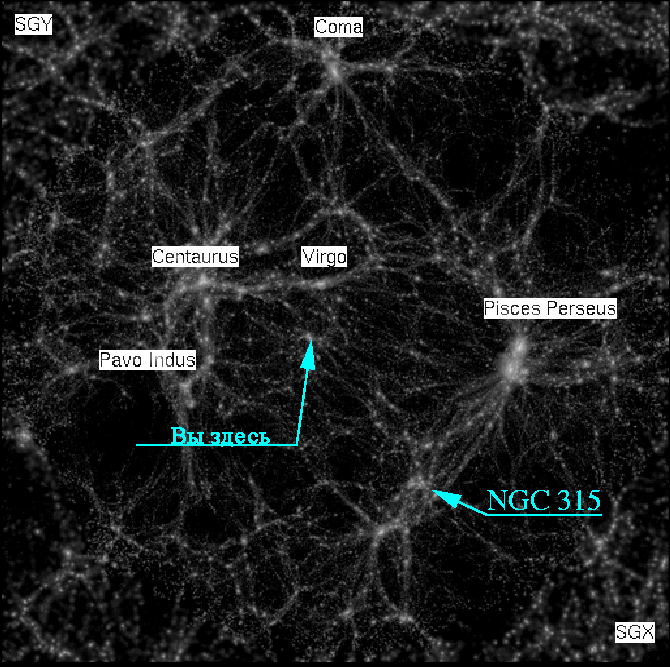Right ascension 10 32 Number of clusters 300–500 | ||
 | ||
Major axis 520×10^ ly (159 Mpc) h−10.6780 ± 0.077(Hubble constant based on Planck data) | ||
The Laniakea Supercluster (Laniakea; also called Local Supercluster or Local SCl or sometimes Lenakaeia) is the galaxy supercluster that is home to the Milky Way and approximately 100,000 other nearby galaxies. It was defined in September 2014, when a group of astronomers including R. Brent Tully of the University of Hawaii and Hélène Courtois of the University of Lyon published a new way of defining superclusters according to the relative velocities of galaxies. The new definition of the local supercluster subsumes the prior defined local supercluster, the Virgo Supercluster, now an appendage.
Contents
Characteristics
The Laniakea Supercluster encompasses approximately 100,000 galaxies stretched out over 160 megaparsecs (520 million light-years). It has the approximate mass of 1017 solar masses, or a hundred thousand times that of our galaxy, which is almost the same as that of the Horologium Supercluster. It consists of four subparts, which were known previously as separate superclusters:
The most massive galaxy clusters of Laniakea are Virgo, Hydra, Centaurus, Abell 3565, Abell 3574, Abell 3521, Fornax, Eridanus and Norma. The entire supercluster consists of approximately 300 to 500 known galaxy clusters and groups. The real number may be much larger because some of these are traversing the Zone of Avoidance, making them essentially undetectable.
Superclusters are some of the universe's largest structures and have boundaries that are difficult to define, especially from the inside. The team used radio telescopes to map the motions of a large collection of local galaxies. Within a given supercluster, most galaxy motions will be directed inward, toward the center of mass. In the case of Laniakea, this gravitational focal point is called the Great Attractor, and influences the motions of the Local Group of galaxies, where the Milky Way galaxy resides, and all others throughout the supercluster. Unlike its constituent clusters, Laniakea is not gravitationally bound and is projected to be torn apart by dark energy.
Discovery method
The new method used to analyse galaxy movements to distinguish peculiar motion from cosmic expansion is Wiener filtering, which works for well-defined positional information, allowing analysis out to about 300×10^6 ly (92 Mpc), showing flow patterns. With that limitation, Laniakea is shown to be heading in the direction of the Shapley Supercluster, so both Shapley and Laniakea may be part of a greater complex.
South African astronomer Tony Fairall stated in 1988 that redshifts suggested that the Virgo and Hydra-Centaurus Superclusters may be connected.
Location
The neighbouring superclusters to Laniakea are the Shapley Supercluster, Hercules Supercluster, Coma Supercluster and Perseus-Pisces Supercluster. The edges of the superclusters and Laniakea were not clearly known at the time of Laniakea's definition.
Name
The name laniakea means "immense heaven" in Hawaiian, from lani for "heaven" and akea for "spacious" or "immeasurable". The name was suggested by Nawa'a Napoleon, an associate professor of Hawaiian language at Kapiolani Community College. The name honors Polynesian navigators, who used knowledge of the heavens to navigate the Pacific Ocean.
